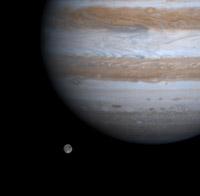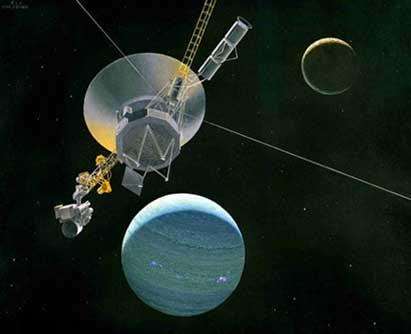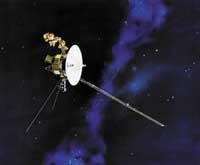From earth to space
2007/03/01 Etxebeste Aduriz, Egoitz - Elhuyar Zientzia Iturria: Elhuyar aldizkaria
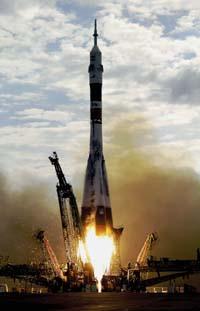
For this it is necessary to obtain a kinetic energy capable of dealing with this potential energy, or what is the same, a speed that allows to cope with gravity. It is called escape velocity at the minimum speed necessary to leave a gravitational field and on surface is 11.2 km/s. That is, if a surface body is given that speed, it will have enough kinetic energy to escape the gravitational field of Earth.
To overcome this first problem you need a big rocket full of kings to the neck. In fact, the fuel needed to send a load to space weighs more than the load itself.
Burning this fuel, the hot gas is directed in one direction and at high speed, and by action reaction gets the push that the rocket goes up. The rocket does not start at a speed of 11.2 km/s, but by continuing to burn fuel on the road, more kinetic energy is obtained and with this sufficient starting speed.
But the rockets only serve to travel one-way. They cannot be reused. As they advance on the journey, the parts are released to reduce weight and increase speed, and end up lost in the sea, in the orbit of Earth or in space. They do not recover.
The Russians, for example, use Soyuz rockets to move astronauts to the International Space Station (ISS), and then land on a capsule. There are 3 astronauts on the Soiuz rockets and a new rocket must be used every trip.
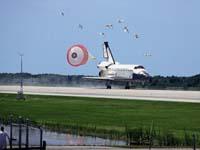
Americans, for their part, use space ferries to travel back and forth. Unlike rockets, they are somewhat reusable. The launch is done in the same way as the rockets, but they are able to land as planes, so they can be used repeatedly. NASA transborders are designed for a hundred flights, with capacity for 5-7 astronauts per trip. However, since the Columbia accident in 2003 they are in decline and practically out of use. In addition, according to NASA's 2004 declarations, the withdrawal of the ferries is expected for 2010 and its replacement by space ships of Orio in development phase. And these new spacecraft will serve to go first to the Moon and then to Mars.
But both the flights of Soiuz rockets and space ferries are usually orbital, that is, they do not go beyond the Earth's orbit. At present, they are the only trips made by the human being.
First stop: The moon
Leaving behind orbital journeys, the closest stop of space is the Moon. In fact, it is also found in the orbit of the Earth.
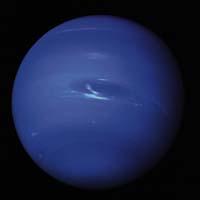
At present almost all space agencies have projects to return to the moon. European, Chinese, Japanese and US space agencies plan to go to the moon by 2020. And also the Indians and the Russians in 2030. But they not only talk about going, but staying there, because they have plans to build a fixed base. The Japanese want to make the base by 2030, while the Chinese and Americans claim it may be made by 2024. They are now trying to reach international agreements.
NASA and ESA also look beyond the Moon and see the Moon as an intermediate step towards Mars. The ESA Aurora programme, for example, aims to reach Mars by 2030.
To the planets
But, for now, only space probes travel to planets. These probes are placed at the end of the rockets to be able to leave the ground. That is, the rocket is in charge of giving speed to the probe and then, once left the influence of the Earth, the rocket can be left behind and go for inertia wherever you want. But for this it is necessary to give the proper direction. And in that you have to be very fine, since the size of the planets is very small compared to their orbit.
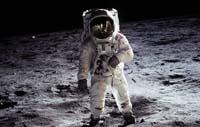
For the probe to reach the desired target, gravity simulators perform very precise calculations. These simulators simulate the path of the probe, taking into account the gravity of all other planets and masses, calculating in addition to the direction to give the probe the exact time of launch. This is called the launch window.
However, the probe itself also has small thrusters for direction corrections. Therefore, the rocket gives you speed and direction, but then corrections can be made on the way.
Impact free candy
As already indicated, sending a probe to a planet must take into account the gravity of the planets that will act along the way. But not only is it taken into account, you can also use the gravitational field of the planets to achieve greater speed. This is called gravitational aid. For example, the gravitational aid of Jupiter and Saturn can be very useful for going to Uranus.
To benefit from gravitational aid it is necessary to direct the probe behind a large mass planet. That is, to pass the probe through the point that just passed the planet in its orbit. In this way, the planet will attract and therefore give you speed. Once the speed is reached, you can jump to the next planet as if it were a billiard space game. In addition, this way of traveling allows observing several planets in the same mission.
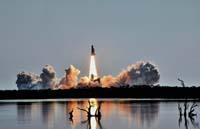
The Voyager 2 probe left Titan and, in addition to Jupiter and Saturn, visited Uranus and Neptune in 1986 and 1989. Voyager 2 is the only one who has visited these last two planets.
Gravitational support is so useful that sometimes travel can start in the opposite direction. To send to Saturn Cassini-Huygens, he was first sent to Venus. There he received gravitational aid twice and then, with the help of Earth and Jupiter, he used to reach Saturn.
Right now, the New Horizons probe has just had the help of Jupiter, or is doing so to reach Pluto and Karon. However, while near Jupiter, he is taking pictures to study that planet and its four largest moons. This work, which will last until June, hopes to reach Pluto by 2015. If he did not have the help of Jupiter's gravitation, it would take four more years to reach Pluto.
Next stop: Mars?
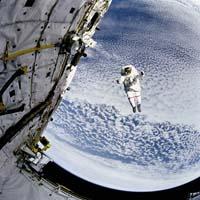
Although space probes have come very far, in the case of man things get very complicated. After returning to the Moon, space agencies have set the next target on Mars. But it will not be easy. In fact, the mission here to Mars can be almost two years. Today, that means astronauts should live two years without gravity. And the human body is not able to live without gravity for so long.
In the absence of gravity, bones lose calcium, muscles atrophy, the cardiovascular system slows down, fewer red blood cells form, and the immune system weakens, among other things. In fact, it is often mentioned that lack of gravity resembles processes that occur with age. Therefore, such trips would require spacecraft that generate artificial gravity. But, for the moment, it does not exist.
Those who dream of going to the planets as tourists, so they will have to face, for the moment, the realization of orbital flights. To do this, keep your pocket warm. The Russian Space Agency offers space travel for 15 million euros and all flights until 2009 are busy.
A walk through space
The first tourist of the space was Dennis Tito, who spent seven days on the ISS in 2001. They have been and will be more. In addition, there are many entrepreneurs who have heard money in space travel and there are several projects underway. The majority propose vehicles that will carry out suborbital flights and plan to travel at a height of between 100 and 160 kilometers.
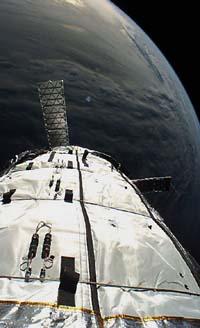
SpaceShipOne spacecraft can be one of those used for this type of travel. It is the first spacecraft financed exclusively by private money that in 2004, within two weeks, managed to climb twice to 100 kilometers of height, with 3 people inside. Now they want to launch a fleet of such spacecraft to complete the Virgin Galactic space line. They have already started booking flights and expect the first flight to take place in 2008.
Another private project is Blue Origin. Recently the video of the flight of the first prototype named Goddard was shown in November 2006. Goddard's appearance is curious: it has a bell shape and four legs, and he says goodbye and lands vertically. In this first test he only climbed to 85 meters. However, it is expected to start offering commercial flights 100 kilometers by 2010. In these flights, in addition to the pilot, it is expected that three other people will attend.
Hotels of a thousand stars
But in addition to travel, there are those who want to start the business of space accommodation. Bigelow Aerospace takes up the design of the inflatable space habitats of the Transhab program abandoned by NASA in its day and already in July 2006 sent to orbit the test module Genesis 1. This year they plan to ship Genesis 2 and launch the first commercial space station for 2010. It will be called Nautilus and will have 330 m 3.
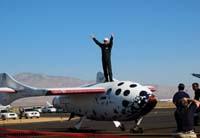
Will the colonization of space begin with space accommodation? At least some believe this will come sooner or later. NASA CEO Michael Griffin spoke: "...in the long term, the species of planet Earth cannot survive... If human beings want to live hundreds, thousands or millions of years, we must colonize other planets... I don't know when it will be, but there will come a day when more people will live outside the Earth than on Earth... I know that man will colonize the solar system and someday he will go further..."
Based on the interview with engineer Danel Madariaga on the radio program Norteko Ferrokarrilla. To listen to the interview: www.elhuyar.com/norteko_ferrokarrilla/
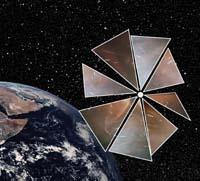
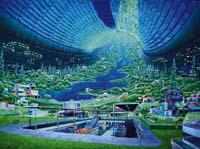

Gai honi buruzko eduki gehiago
Elhuyarrek garatutako teknologia



